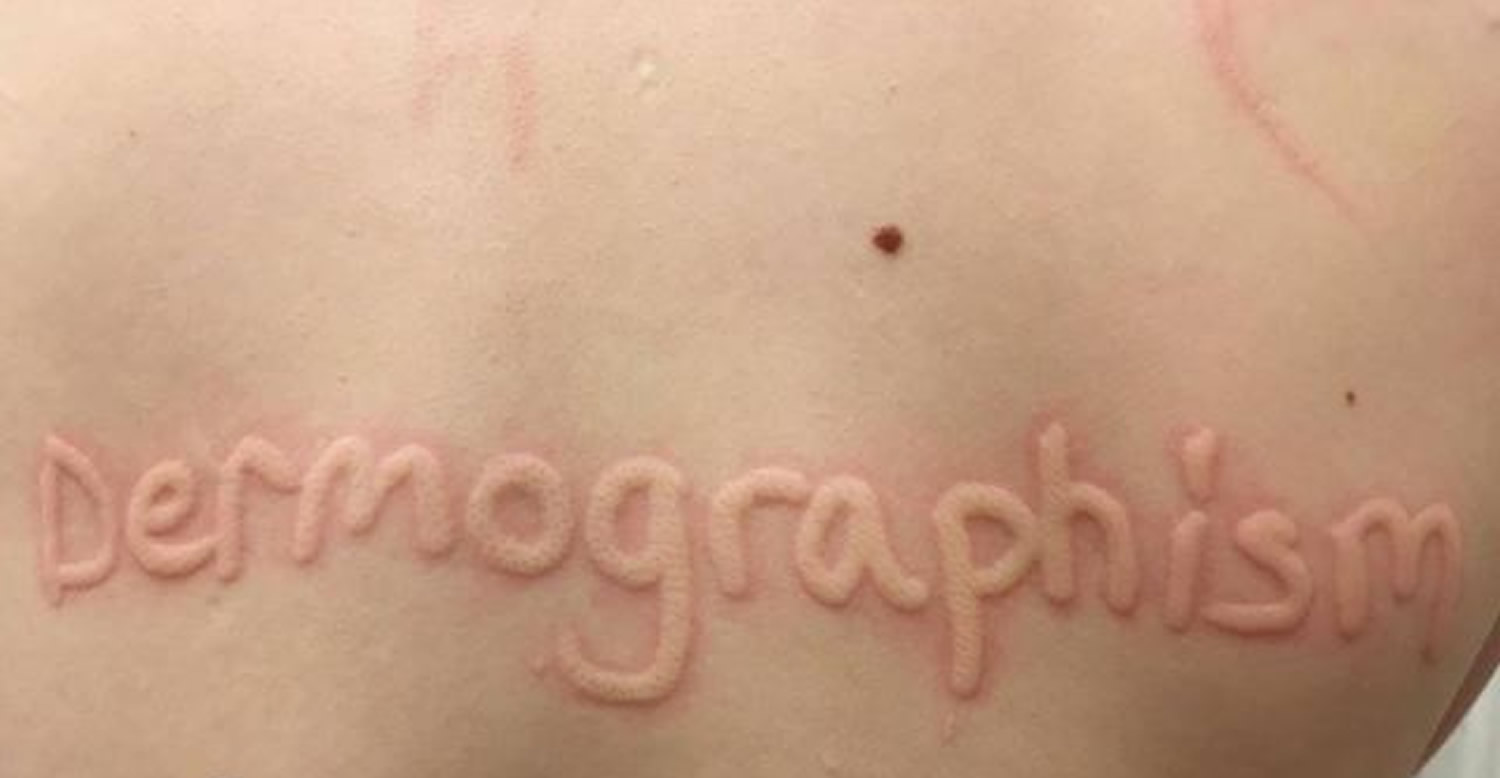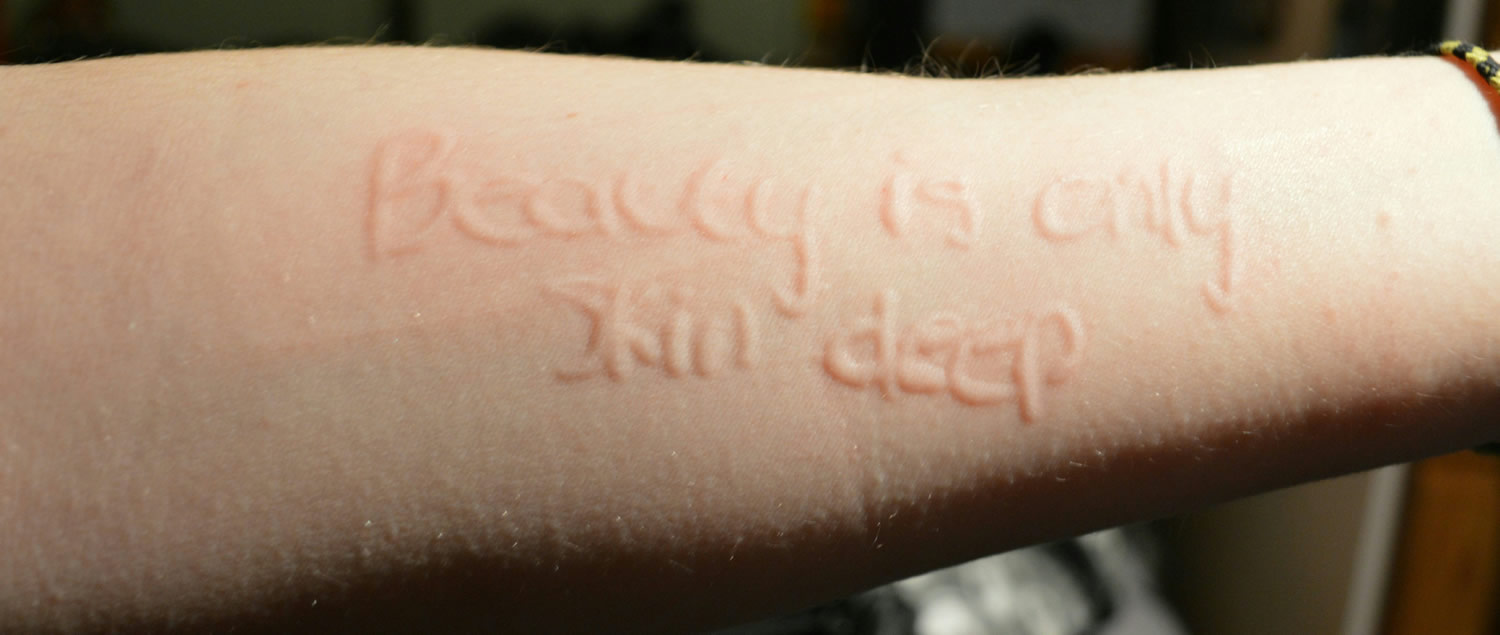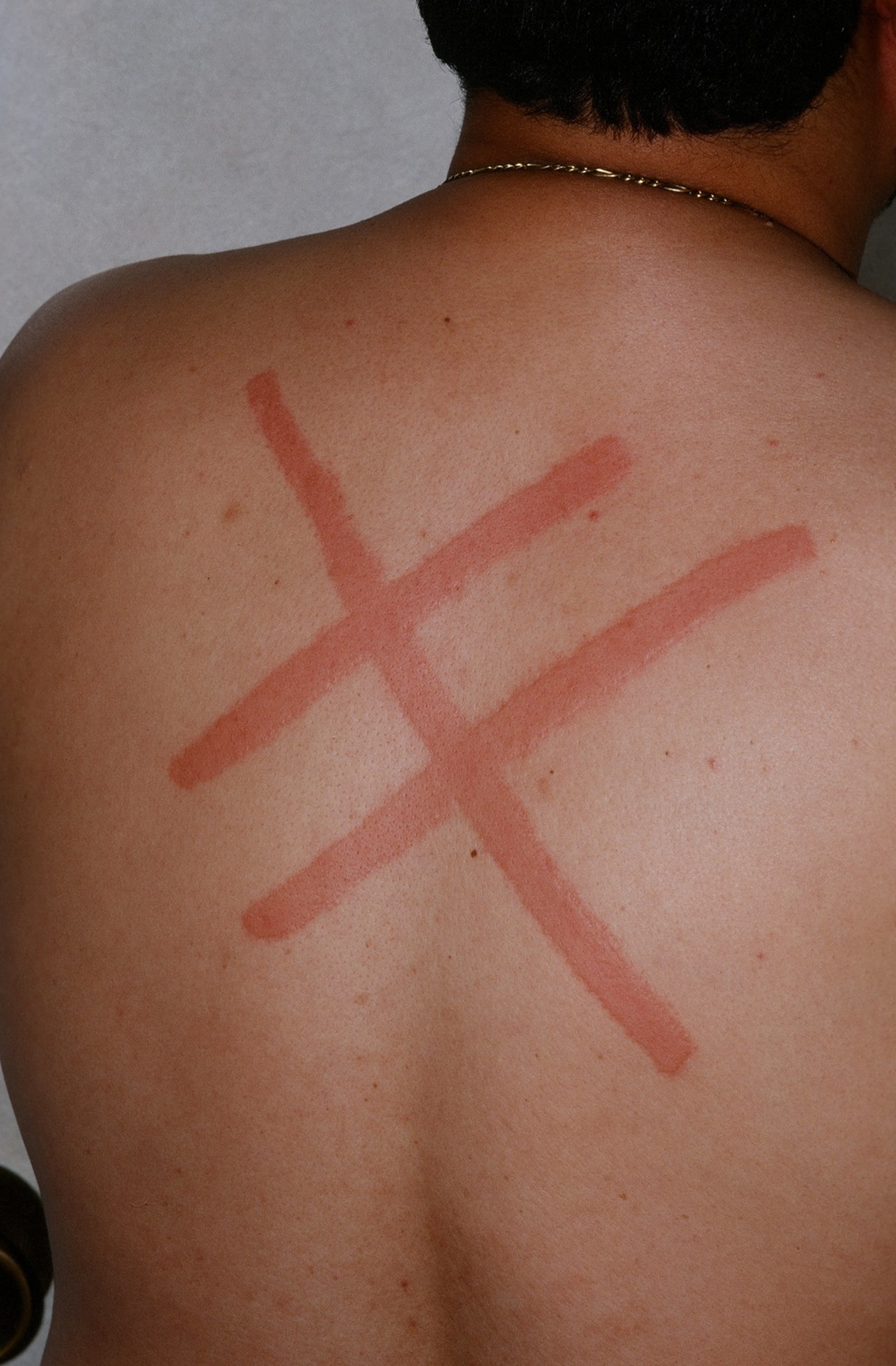Contents
What is dermatographia
The term dermatographia sometimes also called dermographism, dermatographism or dermatographic urticaria, literally means writing on the skin. Dermatographia (dermographism) is an exaggerated wealing tendency when the skin is stroked. It is the commonest form of physical urticaria. Firm stroking of the skin produces an initial red line (capillary dilatation), followed by an axon-reflex flare with broadening erythema (arteriolar dilatation) and the formation of a linear wheal (transudation of fluid/edema); these events are collectively termed the triple response of Lewis. These marks usually disappear within 30 minutes.
In 25-50% of normal people firm stroking of the skin produces first a white line, then a red line, then slight swelling down the line of the stroke, and a mild red flare in the surrounding skin. In approximately 2-5% of the population this response is exaggerated enough to be called dermatographia (dermographism). In only a minority of these does it cause any symptoms like itching (symptomatic dermographism).
Dermatographia can appear at any age but is most common in young adults.
- Dermatographia can occur with other types of urticaria (hives) including those due to cold or pressure.
- An association with thyroid disease has been noted, but is likely a reflection of an underlying tendency to autoimmune disease and does not appear to have a causative relationship.
People with dermatographia are usually otherwise healthy.
The cause of dermatographia is unknown, but it can be triggered in some people by infections, emotional upset or medications such as penicillin.
Most people who have dermatographia don’t seek treatment. If your signs and symptoms are especially bothersome, your doctor may recommend allergy medications such as cetirizine (Zyrtec) or diphenhydramine (Benadryl).
Figure 1. Dermatographia
Is dermatographia permanent?
Dermatographia may last for months or go on indefinitely. In many patients, however, it clears within a year or two, or at least the wealing is reduced to a degree which no longer causes significant symptoms.
Dermatographia causes
What causes dermatographia
The exact cause of dermatographia or dermographic urticaria is unknown. Histamine is the main chemical released by mast cells when the skin is stroked, but other chemical mediators may also be involved.
Some patients with severe dermatographia may carry an autoantibody to some unknown cutaneous protein.
Occasionally dermatographia is triggered by an allergy to some external agent such as penicillin, scabies or a worm infestation. Most people with dermatographia do not have an allergy.
Simple things can trigger symptoms of dermatographia. For example, rubbing from your clothes or bed sheets may irritate your skin. Sometimes, dermatographia is preceded by an infection, emotional upset or medications, such as penicillin.
Risk factors for dermatographia
Dermatographia can occur at any age, but it tends to be more common in teenagers and young adults. If you have other skin conditions, such as dry skin or dermatitis, you may be more susceptible to dermatographia. Any skin condition that causes a frequent urge to scratch may increase your risk.
Dermatographia prevention
To reduce discomfort and prevent the symptoms of dermatographia, try these tips:
- Avoid irritating your skin. Refrain from using harsh soaps on your skin. Don’t wear clothing made of itchy material, such as wool. Hot showers or baths may worsen the symptoms.
- Don’t scratch your skin. If you have dermatographia or other skin conditions that may cause frequent itching, try to avoid scratching your skin. Scratching will aggravate the condition.
- Keep your skin moisturized. Dry skin tends to make skin itchy. Keep your skin moisturized by using lotions and creams after bathing.
Dermatographia symptoms
The signs and symptoms may occur within a few minutes of your skin being rubbed or scratched and usually disappear within 30 minutes. Rarely, dermatographia develops more slowly and lasts several hours to several days.
Signs and symptoms of dermatographia may include:
- Raised red lines
- Swelling
- Inflammation
- Hive-like welts
- Itching
The onset of dermatographia is usually gradual, but in some the condition develops over a few days. Aggravating factors may include:
- Hot conditions, for example, a warm bath, shower or bed
- Toweling after bathing
- After exercise, especially if it is accompanied by knocks, such as occur in rugby, wrestling or boxing
- Minor pressure from clothing, chair seats, working with tools, clapping the hands, and other minor forms of pressure on the skin
- Nervousness, agitation and worrying situations.
Once a few weals develop, subsequent scratching readily starts others in the vicinity.
- The weals are usually on the surface but some deep extension may occur and giant weals develop.
- The weals die away rapidly and usually clear after half to one hour.
The condition itself can last for months or years.
Dermatographia diagnosis
Your doctor can diagnose dermatographia with a simple test. He or she will draw a tongue depressor across the skin of your arm or back to see if a red, swollen line or a welt (wheal) appears within a few minutes.
Dermatographia treatment
Symptoms of dermatographia usually go away on their own, and treatment for dermatographia generally isn’t necessary. However, if the condition is severe or bothersome, your doctor may recommend antihistamine medications such as diphenhydramine (Benadryl), fexofenadine (Allegra) or cetirizine (Zyrtec).
Chronic urticaria has been associated with low vitamin D levels and supplementation improves response to standard therapy 1.
General measures include avoiding the stimuli that set off bouts of itch, where possible. For example:
- Choose comfortable, loose clothing
- Avoid exposure to very hot water
- Pat dry gently after bathing
- If suspicious of a drug cause, consider stopping it if safe to do so.
Antihistamines usually give good relief from symptoms. Non-sedating options include:
- Cetirizine 10-20 mg oral once to two times daily
- Loratidine 10 mg tablets once daily
- Fexofenadine 180 mg oral once to two times daily
Antihistamines may need to be continued daily for at least several months; intermittent therapy is of less value.
H1 antihistamines are the drugs of choice. In some patients, a combination of 2 or more antihistamines may be required. Sedating antihistamines such as hydroxyzine can be helpful. Regular treatment may have to be continued for several months. In a self-reported questionnaire of patients taking H1 antihistamines, 18 (23%) of 79 were completely free from symptoms, 39 (49%) of 79 had a marked improvement, and only 3 (4%) of 79) reported no effect 2. The addition of H2-receptor antagonists appears to result in little symptomatic benefit, although some studies have shown a further small reduction in the whealing response 3. Physical urticarias are usually unresponsive to systemic corticosteroids.
Omalizumab, a recombinant humanized monoclonal antibody against immunoglobulin E (IgE), has been successfully used in patients with physical urticaria, including symptomatic dermographia. It is administered subcutaneously at an initial dosage of 150 mg/month, but the dosage can be increased to 300 mg/month. Some patients have reported complete symptom resolution within days after the first injection 4. Omalizumab was successfully used in a woman with 3 subtypes of chronic urticaria, including symptomatic dermographia 5. Treatment was continued throughout the patient’s pregnancy without any complications or obvious adverse effects, although the frequency of injections had to be increased to every 15 days. Reinitiation of omalizumab treatment after relapse of disease appears to result in rapid and complete symptom control again after the first injection within the first 4 weeks, and no relevant adverse effects have been reported 6.
Resistant cases may find phototherapy helpful.
Narrowband ultraviolet (UV)-B phototherapy and oral psoralen plus UV-A light therapy have both been used as treatments for symptomatic dermographism. Subjective relief of pruritus and whealing and objective reduction of wheals have been reported 7. However, the improvement is short-lived, and most patients relapse within 2-3 months of completing phototherapy.
Dermatographia diet
Please always remember that there is no such thing as an “histamine-free diet”! A low-histamine diet for a period of 3–4 weeks in patients with chronic spontaneous urticaria reduced symptoms and antihistamine intake as well as to improve quality of life 8. It is important to eat foods that are low in histamine levels in accordance to your threshold. Briefly, such a diet avoids cheese, preserved meats, strawberries, raspberries, citrus fruit, bananas, kiwis, plums, papaya and alcohol. It includes foods such as dairy, vegetables, fresh meats, eggs, bread, pasta, rice and certain varieties of fish.
Here are some general pointers:
- Avoid or reduce eating canned foods and ready meals
- Avoid or reduce eating ripened and fermented foods (older cheeses, alcoholic drinks, products containing yeast, stale fish)
- Histamine levels in foods vary, depending on how ripe, matured or hygienic the foods are
- As much as it is possible, only buy and eat fresh products
- Don’t allow foods to linger outside the refrigerator – especially meat products
- Ensure that your food preparation area (kitchen) is always kept clean – but don’t be manic!
- Everyone has their own threshold; you will need to find yours
- Consult a certified dietician about working out a balanced diet
- Learn to cook. It can be loads of fun once you get into it
Low histamine level foods:
- Fresh meat (cooled, frozen or fresh)
- Freshly caught fish
- Chicken (skinned and fresh)
- Egg yolk
- Fresh fruits – with the exception of strawberries, most fresh fruits are considered to have a low histamine level (also see histamine liberators below)
- Fresh vegetables – with the exception of tomatoes
- Grains – rice noodles, yeast free rye bread, rice crisp bread, oats, puffed rice crackers, millet flour, pasta (spelt and corn based)
- Fresh pasteurized milk and milk products
- Milk substitutes – coconut milk, rice milk
- Cream cheese, butter (without the histamine generating rancidity)
- Most cooking oils – check suitability before use
- Most leafy herbs – check suitability before use
- Most non-citric fruit juices
- Herbal teas – with the exception of those listed below
High histamine level foods:
- Alcohol
- Pickled or canned foods – sauerkrauts
- Matured cheeses
- Smoked meat products – salami, ham, sausages….
- Shellfish
- Beans and pulses – chickpeas, soy beans, peanuts
- Nuts – walnuts, cashew nuts
- Chocolates and other cocoa based products
- Vinegar
- Ready meals
- Salty snacks, sweets with preservatives and artificial colorings
Histamine liberators:
- Most citric fruits – kiwi, lemon, lime, pineapple, plums…
- Cocoa and chocolate
- Nuts
- Papaya
- Beans and pulses
- Tomatoes
- Wheat germ
- Additives – benzoate, sulphites, nitrites, glutamate, food dyes
Diamine Oxidase (DAO) blockers:
- Alcohol
- Black tea
- Energy drinks
- Green tea
- Mate tea
Debatable:
- Yogurt – depends on the bacteria culture used
- Egg white – it is a histamine liberator only when in its raw state
Other
- Yeast – even though it does not contain histamine as such, yeast serves as a catalyst for histamine generation during manufacture. There is no yeast in the end product.
- Rasool R, et al. World Allergy Organ J. 2015[↩]
- Schoepke N, Mlynek A, Weller K, Church MK, Maurer M. Symptomatic dermographism: an inadequately described disease. J Eur Acad Dermatol Venereol. 2015 Apr. 29(4):708-12.[↩]
- Sharpe GR, Shuster S. In dermographic urticaria H2 receptor antagonists have a small but therapeutically irrelevant additional effect compared with H1 antagonists alone. Br J Dermatol. 1993 Nov. 129(5):575-9.[↩]
- Metz M, Altrichter S, Ardelean E, at al. Anti-Immunoglobulin E Treatment of Patients with Recalcitrant Physical Urticaria. Int Arch Allergy Immunol. 2011. 154:177-180.[↩]
- Vieira Dos Santos R, Locks Bidese B, Rabello de Souza J, Maurer M. Effects of Omalizumab in a patient with three types of chronic urticaria. Br J Dermatol. 2013 Sep 14.[↩]
- Metz M, Ohanyan T, Chruch MK, Maurer M. Retreatment with omalizumab results in rapid remission in chronic spontaneous and inducible urticaria. JAMA Dermatol. 2014 Mar. 150(3):288-90.[↩]
- Borzova E, Rutherford A, Konstantinou GN, Leslie KS, Grattan CE. Narrowband ultraviolet B phototherapy is beneficial in antihistamine-resistant symptomatic dermographism: A pilot study. J Am Acad Dermatol. Sept 2008. 59:752-7.[↩]
- JEADV 2017;31;650[↩]







